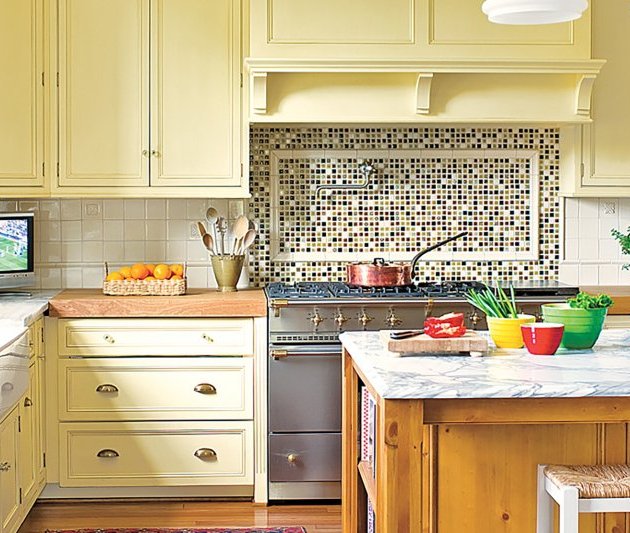
Don’t visit a showroom or meet with a pro without our expert advice on creating the cook space you’ve always coveted.
Get the Pros Involved

A kitchen remodel is a big deal—not something to be approached rashly. So before you even visit a showroom or meet with a pro, read our expert advice on creating the cook space you’ve always coveted.
Make Cents Out of Your Remodel

Worth the Splurge
1) Second sink: Place it outside of the main cooking and cleanup zone so that a second chef can prep food, wash hands for dinner, or bartend during parties.
2) Paneled cabinet ends: These decorative panels, which are essentially oversize doors fixed to any exposed sides of cabinets, give your kitchen a custom-built, furniture-like look.
3) Full-extension, soft-close drawer glides: Installed under or on the sides of a drawer, they allow it to pull completely out of the cabinet so that you can reach everything inside. Plus, they eliminate slamming.
Not Worth the Splurge
1) Glazed, distressed, and crackled finishes: These can increase cabinet costs by as much as 30 percent and can start to look dated as trends change.
2) Pot filler: It does make filling the pasta pot easier, but it doesn’t help with the far worse task of carting boiling water to the sink when your fettuccine is done.
3) Wine fridge: Do you really need 18 bottles of Pinot within arms reach and kept at precisely 55 degrees?
Allocating Project Costs

Whether your budget is $5,000 or $50,000, here’s how it tends to be allocated.
Designer’s Cheat Sheet

To create a comfortable and good-looking kitchen, consider these rules of thumb for installing cabinets, countertops, and lighting.
Easiest way to save big: Keep your current layout. Taking down walls, and moving gas lines, plumbing connections, and electrical wiring will quickly erode your budget.
Three Ways to Save on Cabinets

1. Choose a manufacturer that offers the door style and finish you want as a standard option, with no up-charge.
2. Don’t pay for factory-built or custom organizers. Aftermarket utensil dividers, rollout trays, and back-of-the-door spice racks are a fraction of the cost at websites such as organize.com and cabinetparts.com.
3. Avoid custom configurations. You can often use stock wine organizers, cubby units, and even appliance panels to fill awkward spaces that might otherwise require you to buy a custom cabinet.
How the Factory’s Cabinets Beat the Woodshop’s

The big guys may not offer the customization you get from a local craftsman, but factory-made-to-order cabinets have the following benefits:
1. Warranties of up to 25 years on cabinets, accessories, workmanship, and internal hardware.
2. Controlled environment that yields more stable wood, which reduces warping and splitting later.
3. Computerized cutting tools that offer more precise joinery than anything done by hand.
4. Baked-on finishes that are more durable than local guys’ air-dried ones. Dust-free finishing rooms also provide a smooth-as-glass surface.
Which Under-Cabinet Lighting?

For task light, pick one of these low-voltage strips or pucks.
XENON Accurate color, wide beam, and dimmable, but can get hot to the touch. Widely available at home centers and kitchen showrooms. $25–$125 for a 24-inch cabinet uninstalled
LED Energy-efficient, long-lasting bulbs; so thin you don’t need much of a lip to hide fixtures. Can have a bluish tint unless rated at 3,500 or lower on the Kelvin scale. A new technology, so pricier and harder to source. $75–$190 for a 24-inch cabinet uninstalled.
Display Cabinets for Less

Rather than stacking glass-doored cubby units over upper cabinets, just order tall two-panel wall cabinets with squares of glass at the top. You’ll save 25 to 45 percent.
Blind Corners: Half-Moon Lazy Susan

Blind Corners: Double Sliding Shelves

Blind Corners: Pull-Out Shelves

Two height-adjustable peanut-shaped shelves snake out and to the side in one fluid motion. The shelves fully extend, so there’s no reaching inside for items tucked in the rear. Häfele Arena Plus Corner Pull-out Shelf, $790; kitchensource.com
Best Practices for Open Shelving

Anything stored on exposed shelves will collect dust, so consider them only for:
• Everyday objects, like coffee cups and cereal bowls, that you wash frequently
• Cookbooks, which don’t show dust and are generally stored in the open anyway
• Oversize items, like soup tureens and serving platters, if you don’t mind giving them a quick rinse
• Wine racks, since bottles won’t fit behind the doors on wall cabinets
The Pros (and Cons) of a Pro-Grade Range

It tops many a kitchen remodeler’s wish list, but is a high-firepower cooker really the right choice for you?
Pros:
Burners can put out two to three times the BTUs with controls that go from simmer to sear.
20-plus-year life expectancy
Heavy-duty all-stainless-steel construction
Comes in many standard sizes; widths of 24 to 60 inches.
Handsomely styled showpiece
Cons
Needs a 10-inch duct (versus the usual 7-inch) for a high-power vent hood to whisk away that extra heat.
Costly parts and service calls
Can weigh more than 900 pounds, requiring extra support in floors.
May stand out 4 inches beyond typical counter depth.
$5,000–$10,000 sticker price
Next-Gen Cook Top

Induction uses an electro-magnetic field to heat stainless-steel or cast-iron cookware.
It offers:
1) The ease of electric with the power and control of gas.
2) Faster and more energy-efficient heating than standard electric.
3) A cool-to-the-touch top that won’t burn the kids.
4) A pro-grade cooktop in an island without running gas lines. Just add an outlet.


